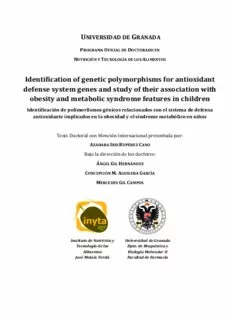
Identification of genetic polymorphisms for antioxidant defense system genes and study of their PDF
Preview Identification of genetic polymorphisms for antioxidant defense system genes and study of their
UNIVERSIDAD DE GRANADA PROGRAMA OFICIAL DE DOCTORADO EN NUTRICIÓN Y TECNOLOGÍA DE LOS ALIMENTOS Identification of genetic polymorphisms for antioxidant defense system genes and study of their association with obesity and metabolic syndrome features in children Identificación de polimorfismos génicos relacionados con el sistema de defensa antioxidante implicados en la obesidad y el síndrome metabólico en niños Tesis Doctoral con Mención Internacional presentada por: AZAHARA IRIS RUPÉREZ CANO Bajo la dirección de los doctores: ÁNGEL GIL HERNÁNDEZ CONCEPCIÓN M. AGUILERA GARCÍA MERCEDES GIL CAMPOS Instituto de Nutrición y Universidad de Granada Tecnología de los Dpto. de Bioquímica y Alimentos Biología Molecular II José Mataix Verdú Facultad de Farmacia Editor: Editorial de la Universidad de Granada Autor: Azahara Iris Rupérez Cano D.L.: GR 1046-2014 ISBN: 978-84-9028-952-5 La doctoranda Azahara Iris Rupérez Cano y los directores de la tesis Ángel Gil Hernández, Concepción M. Aguilera García (Instituto de Nutrición y Tecnología de los Alimentos José Mataix Verdú, Departamento de Bioquímica y Biología Molecular II, Universidad de Granada) y Mercedes Gil Campos (Unidad de Metabolismo e Investigación Pediátrica, Instituto Maimónides de Investigación Biomédica, Servicio de Pediatría, Hospital Universitario Reina Sofía, Córdoba) garantizamos, al firmar esta tesis doctoral, que el trabajo ha sido realizado por el doctorando bajo la dirección de los directores de la tesis y hasta donde nuestro conocimiento alcanza, en la realización del trabajo, se han respetado los derechos de otros autores a ser citados, cuando se han utilizado sus resultados o publicaciones. Granada, 19 de noviembre de 2013 Directores de la tesis Doctoranda Fdo.: ÁNGEL GIL HERNÁNDEZ Fdo.: AZAHARA I. RUPÉREZ CANO Fdo.: CONCEPCIÓN M. AGUILERA GARCÍA Fdo.: MERCEDES GIL CAMPOS TABLE OF CONTENTS Acknowledgements ........................................................................................................................... 7 Grants and funding ............................................................................................................................ 9 List of publications ........................................................................................................................... 11 SUMMARY ........................................................................................................................................... 13 Introduction .............................................................................................................................. 13 Rationale and aims of the study ........................................................................................ 14 Methodology.............................................................................................................................. 14 Results ......................................................................................................................................... 15 Discussion .................................................................................................................................. 17 Conclusion .................................................................................................................................. 20 Limitations of the study ........................................................................................................ 20 RESUMEN GENERAL ...................................................................................................................... 21 Introducción .............................................................................................................................. 21 Fundamento y objetivos ....................................................................................................... 22 Metodología ............................................................................................................................... 22 Resultados .................................................................................................................................. 23 Discusión..................................................................................................................................... 25 Conclusión .................................................................................................................................. 28 Limitaciones del estudio ...................................................................................................... 28 References/Bibliografía ....................................................................................................... 29 INTRODUCTION............................................................................................................................... 31 Childhood obesity ................................................................................................................... 32 Metabolic syndrome in children ....................................................................................... 33 Oxidative stress in obesity................................................................................................... 35 Genetics of obesity .................................................................................................................. 37 Genetic studies ............................................................................................................. 38 1 AIMS OF THE STUDY..................................................................................................................... 41 Background and justification ............................................................................................. 42 Hypothesis ................................................................................................................................. 43 Aims .............................................................................................................................................. 43 General Aims ................................................................................................................ 43 Specific Aims................................................................................................................. 43 METHODOLOGY .............................................................................................................................. 45 Experimental design .............................................................................................................. 46 Anthropometry ........................................................................................................................ 46 Biochemical measurements................................................................................................ 47 Adipokines and biomarkers of inflammation and endothelial damage ........... 48 Antioxidant defense system evaluation ......................................................................... 50 Activity of the antioxidant enzymes in erythrocytes ................................... 50 Determination of paraoxonase 1 activities ...................................................... 51 SNP selection and genotyping ........................................................................................... 53 SNP selection ................................................................................................................ 53 Sample genotyping..................................................................................................... 55 Statistical analysis .................................................................................................................. 57 CHAPTER 1. LITERATURE REVIEW: Genetics of oxidative stress in obesity......... 59 Abstract ....................................................................................................................................... 60 Introduction .............................................................................................................................. 61 Methodology ............................................................................................................................. 62 Oxidative stress in obesity .................................................................................................. 62 Enzymatic antioxidant defence genes ............................................................................ 64 Glutathione peroxidases .......................................................................................... 64 Catalase ........................................................................................................................... 66 Paraoxonases ............................................................................................................... 66 Peroxiredoxins ............................................................................................................ 67 Superoxide dismutases ............................................................................................ 68 2 The ROS producer: NADPH oxidase ................................................................................ 69 ROS response mechanisms: transcription factors ..................................................... 70 PPARγ .............................................................................................................................. 70 PGC1α .............................................................................................................................. 71 NRF2 ................................................................................................................................. 72 Conclusions ................................................................................................................................ 75 Limitations ................................................................................................................................. 75 Acknowledgments .................................................................................................................. 75 Funding........................................................................................................................................ 76 Disclosure statement ............................................................................................................. 76 References .................................................................................................................................. 80 CHAPTER 2. GENERAL RESULTS .............................................................................................. 89 General characteristics of the population under study ........................................... 90 Genotyping results .................................................................................................................. 94 Genotype frequency ................................................................................................... 94 Association with obesity .......................................................................................... 94 Association of gene-specific SNPs with obesity related phenotypes and other biomarkers ...................................................................... 96 CHAPTER 3. Paraoxonase 1 activity and genetic variation in childhood obesity ................................................................................................................................................ 109 Abstract .................................................................................................................................... 110 Introduction ........................................................................................................................... 110 Experimental methods ....................................................................................................... 111 Study population ...................................................................................................... 111 Anthropometric and biochemical measurements ...................................... 111 DNA isolation and genotyping ............................................................................ 111 Determination of paraoxonase 1 activities ................................................... 112 Statistical analyses .................................................................................................. 112 3 Results ...................................................................................................................................... 112 Patient characteristics ........................................................................................... 112 Paraoxonase 1 activities in childhood obesity and their correlations with metabolic, cardiovascular risk and oxidative stress biomarkers .................................................................................................... 112 Association of paraoxonase 1 SNPs with the incidence of childhood obesity and related traits ................................................................ 113 Effects of paraoxonase 1 SNPs on paraoxonase 1 activities .................. 114 Discussion ............................................................................................................................... 115 Conclusion............................................................................................................................... 117 Acknowledgements ............................................................................................................. 117 References............................................................................................................................... 117 Supplementary material ................................................................................................... 119 CHAPTER 4. Are catalase -844A/G polymorphism and activity associated with childhood obesity? ............................................................................................................. 123 Abstract .................................................................................................................................... 124 Introduction ........................................................................................................................... 124 Innovation ............................................................................................................................... 124 Anthropometric and biochemical characteristics of the study population . 125 Correlation of erythrocyte CAT activity with obesity, insulin resistance and oxidative stress biomarkers in plasma .............................................................. 125 Association of CAT SNPs with childhood obesity ................................................... 126 Association of the SNP -844A/G with obesity and insulin resistance biomarkers ............................................................................................................................. 126 Conclusion............................................................................................................................... 126 Notes ......................................................................................................................................... 127 Study population ..................................................................................................... 127 Anthropometric and biochemical measurements ..................................... 128 DNA isolation and genotyping ........................................................................... 128 Statistical analysis ................................................................................................... 128 Acknowledgments ............................................................................................................... 128 4 References ............................................................................................................................... 128 CONCLUSIONS ................................................................................................................................ 131 CONCLUSIONES ............................................................................................................................. 135 REFERENCES .................................................................................................................................. 139 Abbreviations .................................................................................................................................. 145 List of tables ..................................................................................................................................... 148 List of figures ................................................................................................................................... 151 APPENDIX ........................................................................................................................................ 153 Additional publication I ..................................................................................................... 154 Additional publication II ................................................................................................... 160 Table of genotyped SNPs ................................................................................................... 166 Legend .......................................................................................................................... 179 Curriculum Vitae .................................................................................................................. 180 5
Description: